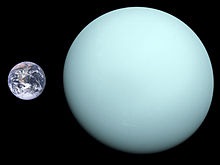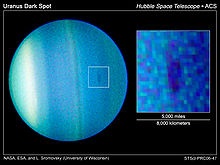 |
| Photographed as a
featureless disc by Voyager 2 in 1986. |
Uranus
Uranus is the seventh planet from the Sun in the Solar
System. It is an ice giant. It is the third largest
planet in the solar system.
The planet is made of ice, gases and liquid metal. Its
atmosphere contains hydrogen (1H), helium (2He) and
methane. The temperature on Uranus is −197 °C (−322.6
°F; 76.1 K) near the top of its atmosphere, but its
small solid core (about 55% the mass of Earth) is
probably about 5,000 K (4,730 °C; 8,540 °F; 5,000 K).
The planet is tilted on its axis so much that it is
sideways. It has five big moons, many small ones, and a
small system of 13 planetary rings.
The distance between Uranus and the Sun is about 2.8
billion km. Uranus completes its orbit around the Sun in
84 earth years. It completes a spin around itself in 17
hours and 14 minutes. This means there are about 43,000
Uranian days in one Uranian year.
Uranus was discovered in 1781. This planet can be seen
with the naked eye under perfect conditions. John
Flamsteed saw it decades earlier but mistook it for a
star (34 Tauri).
Uranus is named after Uranus, the Greek name of the
Sumerian god Anu, who was a god of sky. |
|
 |
| Size comparison of
Earth and Uranus. |
Moons
Uranus has 27 known moons. They are named for characters
from the works of Shakespeare and Alexander Pope. The
five biggest moons are Miranda, Ariel, Umbriel, Titania
and Oberon. Many moons have yet to be discovered.
Exploring
In 1986, NASA's Voyager 2 visited Uranus. This is the
only space probe that tried to investigate the planet
from a short distance.
Clouds
Uranus is covered in blue clouds. The top clouds, made
of methane, are difficult to see. Lower clouds are
thought to be frozen water. There are also violent
storms. Wind speeds can reach 250 metres per second (900
km/h; 560 mph). Scientists are studying the clouds to
try to understand the storms on the planet. |
|
 |
| Uranus in 2005.
Rings, southern collar and a bright cloud in the
northern hemisphere are visible (HST ACS image). |
Rings
The planet Uranus has a system made of 13 rings which is
far fewer than the rings of Saturn but more than those
around Jupiter and Neptune. The rings of Uranus were
discovered in 1977. More than 200 years ago, William
Herschel also reported observing rings, but modern
astronomers do not believe that he saw them, because
they are very dark and faint. Two additional rings were
discovered in 1986 in images taken by Voyager 2, and two
outer rings were found in 2003–2005 by the Hubble Space
Telescope. The rings are probably mainly composed of
frozen water.
The rings of Uranus are thought to be relatively young,
not more than 600 million years old. The Uranian ring
system probably began from the collisional fragmentation
of moons that once existed around the planet. After
colliding, the moons probably broke up into many
particles, which survived as narrow, optically dense
rings only in zones of maximum stability.
General properties
The ring system of Uranus has thirteen distinct rings.
In order of increasing distance from the planet they
are: 1986U2R/ζ, 6, 5, 4, α, β, η, γ, δ, λ, ε, ν, μ
rings. They can be divided into three groups: nine
narrow main rings (6, 5, 4, α, β, η, γ, δ, ε), two dusty
rings (1986U2R/ζ, λ) and two outer rings (μ, ν). The
rings of Uranus consist mainly of macroscopic particles
and little dust, although dust is known to be present in
1986U2R/ζ, η, δ, λ, ν and μ rings.
In addition to these well-known rings, there may be
numerous optically thin dust bands and faint rings
between them. These faint rings and dust bands may exist
only temporarily. Some of them became visible during a
series of ring plane-crossing events in 2007. A number
of dust bands between the rings were observed in
forward-scattering geometry by Voyager 2. All rings of
Uranus show azimuthal brightness variations.
The rings are made of an extremely dark material. The
rings are slightly red in the ultraviolet and visible
parts of the spectrum and grey in near-infrared. They
show no identifiable spectral features. The chemical
composition of the ring particles is not known. However,
they cannot be made of pure water ice like the rings of
Saturn because they are too dark, darker than the inner
moons of Uranus. This shows that they are probably a
mixture of the ice and a dark material. The nature of
this material is not clear, but it may be organic
compounds considerably darkened by the charged particle
irradiation from the Uranian magnetosphere. The rings'
particles may consist of a heavily processed material
which was initially similar to that of the inner moons.
As a whole, the ring system of Uranus is unlike either
the faint dusty rings of Jupiter or the broad and
complex rings of Saturn, some of which are composed of
very bright material—water ice. However, there are
similarities with some parts of the latter ring system;
the Saturnian F ring and the ε ring are both narrow,
relatively dark and are shepherded by a pair of moons.
The newly discovered outer rings of Uranus are similar
to the outer G and E rings of Saturn. Narrow ringlets
existing in the broad Saturnian rings also resemble the
narrow rings of Uranus. In addition, dust bands observed
between the main rings of Uranus may be similar to the
rings of Jupiter. In contrast, the Neptunian ring system
is quite similar to that of Uranus, although it is less
complex, darker and contains more dust. The Neptunian
rings are also positioned further from the planet. |
|
 |
| The first dark spot
observed on Uranus. Image obtained by the HST
ACS in 2006. |
Orbit and rotation
Uranus revolves around the Sun once every 84 Earth
years. Its average distance from the Sun is roughly 3
billion km (about 20 AU). The intensity of sunlight on
Uranus is about 1/400 that on Earth. Its orbital
elements were first calculated in 1783 by Pierre-Simon
Laplace. With time, discrepancies began to appear
between the predicted and observed orbits, and in 1841,
John Couch Adams first proposed that the differences
might be due to the gravitational tug of an unseen
planet. In 1845, Urbain Le Verrier began his own
independent research into Uranus's orbit. On September
23, 1846, Johann Gottfried Galle found a new planet,
later called Neptune, at nearly the position predicted
by Le Verrier.
The rotational period of the interior of Uranus is 17
hours, 14 minutes, clockwise (retrograde). As on all
giant planets, its upper atmosphere experiences very
strong winds in the direction of rotation. At some
latitudes, such as about two-thirds of the way from the
equator to the south pole, visible features of the
atmosphere move much faster, making a full rotation in
as little as 14 hours. |
|
 Kiddle:
Uranus Kiddle:
Uranus
Wikipedia: Uranus |
|